Measures of Central Tendency
Introduction
A measure of central tendency is a single value that attempts to
describe a set of data by identifying the central position within that
set of data. As such, measures of central tendency are sometimes called
measures of central location. They are also classed as summary
statistics. The mean (often called the average) is most likely the
measure of central tendency that you are most familiar with, but there
are others, such as the median and the mode.
The mean, median and mode are all valid measures of central tendency,
but under different conditions, some measures of central tendency
become more appropriate to use than others. In the following sections,
we will look at the mean, mode and median, and learn how to calculate
them and under what conditions they are most appropriate to be used.
Mean (Arithmetic)
The mean (or average) is the most popular and well known measure of
central tendency. It can be used with both discrete and continuous data,
although its use is most often with continuous data (see our Types of Variable
guide for data types). The mean is equal to the sum of all the values
in the data set divided by the number of values in the data set. So, if
we have n values in a data set and they have values x1, x2, ..., xn, the sample mean, usually denoted by  (pronounced x bar), is:
(pronounced x bar), is:
This formula is usually written in a slightly different manner using the Greek capitol letter,  , pronounced "sigma", which means "sum of...":
, pronounced "sigma", which means "sum of...":
You may have noticed that the above formula refers to the sample
mean. So, why have we called it a sample mean? This is because, in
statistics, samples and populations have very different meanings and
these differences are very important, even if, in the case of the mean,
they are calculated in the same way. To acknowledge that we are
calculating the population mean and not the sample mean, we use the
Greek lower case letter "mu", denoted as µ:
The mean is essentially a model of your data set. It is the value
that is most common. You will notice, however, that the mean is not
often one of the actual values that you have observed in your data set.
However, one of its important properties is that it minimises error in
the prediction of any one value in your data set. That is, it is the
value that produces the lowest amount of error from all other values in
the data set.
An important property of the mean is that it includes every value in
your data set as part of the calculation. In addition, the mean is the
only measure of central tendency where the sum of the deviations of each
value from the mean is always zero.
When not to use the mean
The mean has one main disadvantage: it is particularly susceptible to
the influence of outliers. These are values that are unusual compared
to the rest of the data set by being especially small or large in
numerical value. For example, consider the wages of staff at a factory
below:
| Staff | 1 | 2 | 3 | 4 | 5 | 6 | 7 | 8 | 9 | 10 |
| Salary | 15k | 18k | 16k | 14k | 15k | 15k | 12k | 17k | 90k | 95k |
The mean salary for these ten staff is $30.7k. However, inspecting
the raw data suggests that this mean value might not be the best way to
accurately reflect the typical salary of a worker, as most workers have
salaries in the $12k to 18k range. The mean is being skewed by the two
large salaries. Therefore, in this situation, we would like to have a
better measure of central tendency. As we will find out later, taking
the median would be a better measure of central tendency in this
situation.
Another time when we usually prefer the median over the mean (or
mode) is when our data is skewed (i.e., the frequency distribution for
our data is skewed). If we consider the normal distribution - as this is
the most frequently assessed in statistics - when the data is perfectly
normal, the mean, median and mode are identical. Moreover, they all
represent the most typical value in the data set. However, as the data
becomes skewed the mean loses its ability to provide the best central
location for the data because the skewed data is dragging it away from
the typical value. However, the median best retains this position and is
not as strongly influenced by the skewed values. This is explained in
more detail in the skewed distribution section later in this guide.
Median
The median is the middle score for a set of data that has been
arranged in order of magnitude. The median is less affected by outliers
and skewed data. In order to calculate the median, suppose we have the
data below:
| 65 | 55 | 89 | 56 | 35 | 14 | 56 | 55 | 87 | 45 | 92 |
We first need to rearrange that data into order of magnitude (smallest first):
| 14 | 35 | 45 | 55 | 55 | 56 | 56 | 65 | 87 | 89 | 92 |
Our median mark is the middle mark - in this case, 56 (highlighted in
bold). It is the middle mark because there are 5 scores before it and 5
scores after it. This works fine when you have an odd number of scores,
but what happens when you have an even number of scores? What if you
had only 10 scores? Well, you simply have to take the middle two scores
and average the result. So, if we look at the example below:
| 65 | 55 | 89 | 56 | 35 | 14 | 56 | 55 | 87 | 45 |
We again rearrange that data into order of magnitude (smallest first):
| 14 | 35 | 45 | 55 | 55 | 56 | 56 | 65 | 87 | 89 | 92 |
Only now we have to take the 5th and 6th score in our data set and average them to get a median of 55.5.
Mode
The mode is the most frequent score in our data set. On a histogram
it represents the highest bar in a bar chart or histogram. You can,
therefore, sometimes consider the mode as being the most popular option.
An example of a mode is presented below:
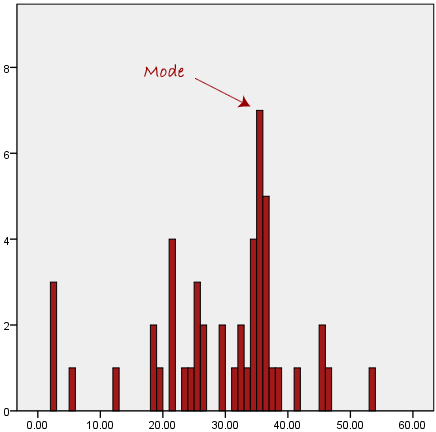
Normally, the mode is used for categorical data where we wish to know which is the most common category, as illustrated below:
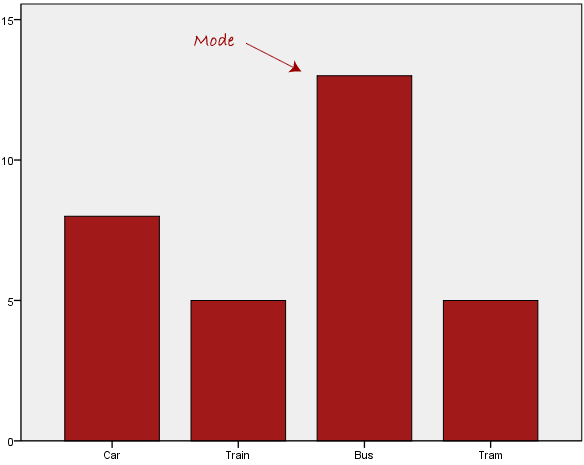
We can see above that the most common form of transport, in this
particular data set, is the bus. However, one of the problems with the
mode is that it is not unique, so it leaves us with problems when we
have two or more values that share the highest frequency, such as below:
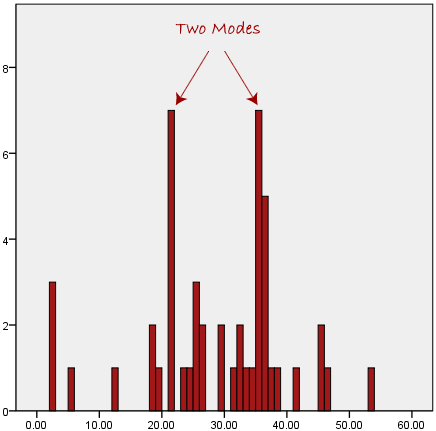
We are now stuck as to which mode best describes the central tendency
of the data. This is particularly problematic when we have continuous
data because we are more likely not to have any one value that is more
frequent than the other. For example, consider measuring 30 peoples'
weight (to the nearest 0.1 kg). How likely is it that we will find two
or more people with exactly the same weight (e.g., 67.4
kg)? The answer, is probably very unlikely - many people might be
close, but with such a small sample (30 people) and a large range of
possible weights, you are unlikely to find two people with exactly the
same weight; that is, to the nearest 0.1 kg. This is why the mode is
very rarely used with continuous data.
Another problem with the mode is that it will not provide us with a
very good measure of central tendency when the most common mark is far
away from the rest of the data in the data set, as depicted in the
diagram below:
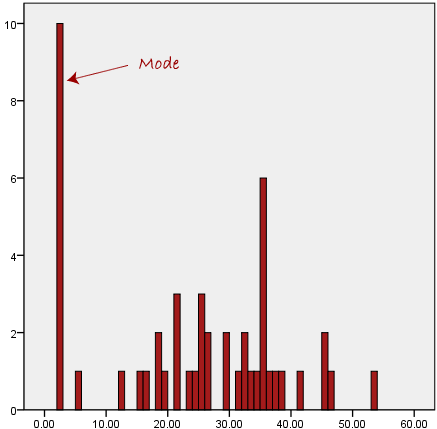
In the above diagram the mode has a value of 2. We can clearly see,
however, that the mode is not representative of the data, which is
mostly concentrated around the 20 to 30 value range. To use the mode to
describe the central tendency of this data set would be misleading.
Skewed Distributions and the Mean and Median
We often test whether our data is normally distributed because this
is a common assumption underlying many statistical tests. An example of a
normally distributed set of data is presented below:
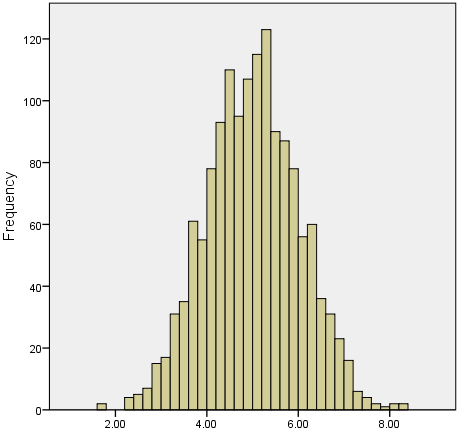
When you have a normally distributed sample you can legitimately use
both the mean or the median as your measure of central tendency. In
fact, in any symmetrical distribution the mean, median and mode are
equal. However, in this situation, the mean is widely preferred as the
best measure of central tendency because it is the measure that includes
all the values in the data set for its calculation, and any change in
any of the scores will affect the value of the mean. This is not the
case with the median or mode.
However, when our data is skewed, for example, as with the right-skewed data set below:
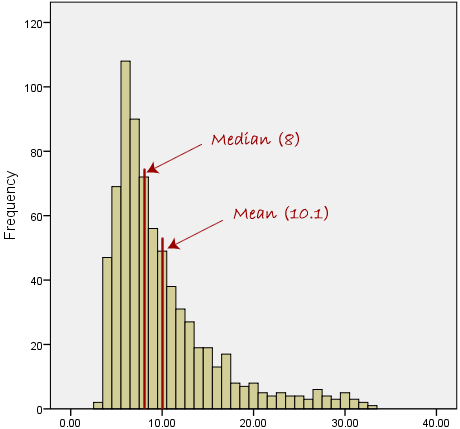
we find that the mean is being dragged in the direct of the skew. In
these situations, the median is generally considered to be the best
representative of the central location of the data. The more skewed the
distribution, the greater the difference between the median and mean,
and the greater emphasis should be placed on using the median as opposed
to the mean. A classic example of the above right-skewed distribution
is income (salary), where higher-earners provide a false representation
of the typical income if expressed as a mean and not a median.
If dealing with a normal distribution, and tests of normality show
that the data is non-normal, it is customary to use the median instead
of the mean. However, this is more a rule of thumb than a strict
guideline. Sometimes, researchers wish to report the mean of a skewed
distribution if the median and mean are not appreciably different (a
subjective assessment), and if it allows easier comparisons to previous
research to be made.
No comments:
Post a Comment